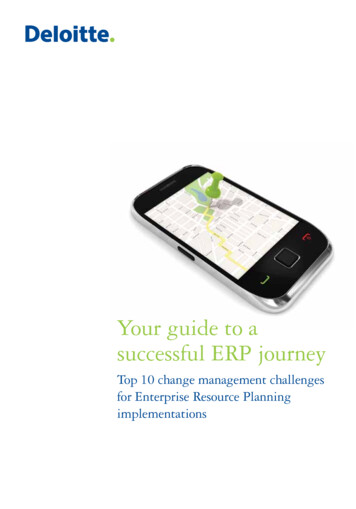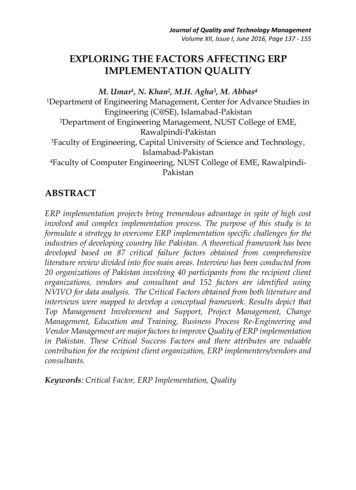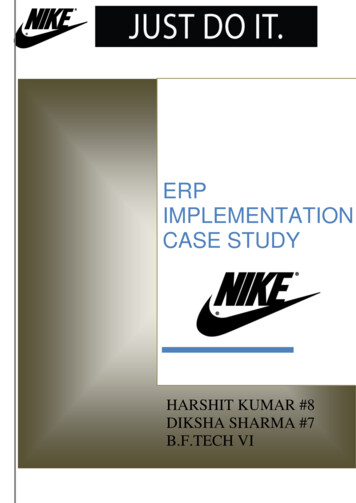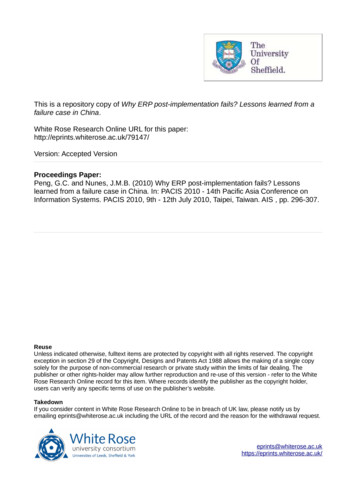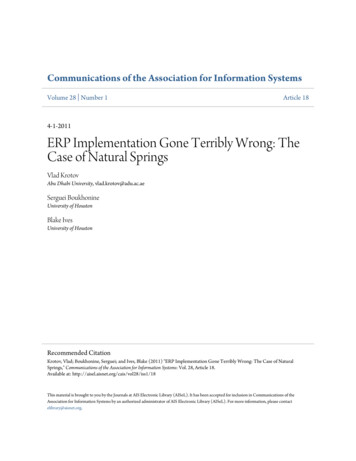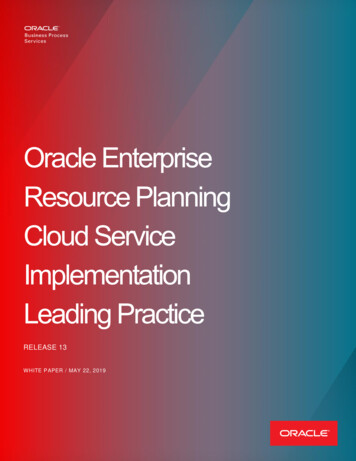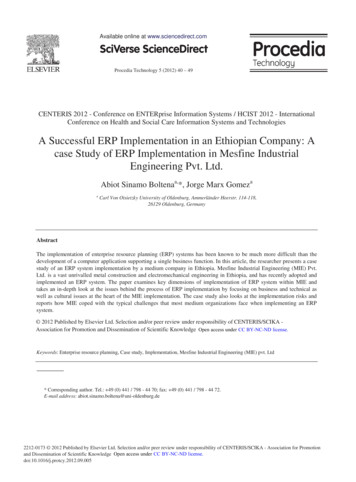
Transcription
Available online at www.sciencedirect.comProcedia Technology 5 (2012) 40 – 49CENTERIS 2012 - Conference on ENTERprise Information Systems / HCIST 2012 - InternationalConference on Health and Social Care Information Systems and TechnologiesA Successful ERP Implementation in an Ethiopian Company: Acase Study of ERP Implementation in Mesfine IndustrialEngineering Pvt. Ltd.Abiot Sinamo Boltenaa,*, Jorge Marx GomezaaCarl Von Oisietzky University of Oldenburg, Ammerländer Heerstr. 114-118,26129 Oldenburg, GermanyAbstractThe implementation of enterprise resource planning (ERP) systems has been known to be much more difficult than thedevelopment of a computer application supporting a single business function. In this article, the researcher presents a casestudy of an ERP system implementation by a medium company in Ethiopia. Mesfine Industrial Engineering (MIE) Pvt.Ltd. is a vast unrivalled metal construction and electromechanical engineering in Ethiopia, and has recently adopted andimplemented an ERP system. The paper examines key dimensions of implementation of ERP system within MIE andtakes an in-depth look at the issues behind the process of ERP implementation by focusing on business and technical aswell as cultural issues at the heart of the MIE implementation. The case study also looks at the implementation risks andreports how MIE coped with the typical challenges that most medium organizations face when implementing an ERPsystem. 2012 PublishedElsevier Ltd.SelectionLtd.and/orpeer reviewunderpeer-reviewresponsibilityof CENTERIS/SCIKA 2012byPublishedby ElsevierSelectionand/orunderresponsibility ofOpenaccessunderCCBY-NC-ND cientificKnowledgeCENTERIS/HCIST.Keywords: Enterprise resource planning, Case study, Implementation, Mesfine Industrial Engineering (MIE) pvt. Ltd* Corresponding author. Tel.: 49 (0) 441 / 798 - 44 70; fax: 49 (0) 441 / 798 - 44 72.E-mail address: abiot.sinamo.boltena@uni-oldenburg.de2212-0173 2012 Published by Elsevier Ltd. Selection and/or peer review under responsibility of CENTERIS/SCIKA - Association for Promotionand Dissemination of Scientific Knowledge Open access under CC BY-NC-ND license.doi:10.1016/j.protcy.2012.09.005
Abiot Sinamo Boltena and Jorge Marx Gomez / Procedia Technology 5 (2012) 40 – 491. IntroductionFirms around the world have been implementing ERP systems since the 1990s to have a uniforminformation system in their respective organizations and to re-engineer their business processes [1]. ERPsystem implementation process involves a wide range of complicated resources and issues. With no plan orsupporting procedure, companies may spend tons of money, resource, and time on ERP implementation butnot enjoy a bit of the benefit ERP system should have brought out [2-10]. A successfully implemented ERPsystem has the advantages of reduced cost and high system quality [11]. It can also yield benefits to itscustomers not only because they can purchase products or goods at low prices resulting from the cost savingsbut also because they share the data of the production line in real time [12]. The benefit of ERP systems ishighly dependent on the success of its implementation. In order to get the best out of ERP system theimplementation must be managed as a program of wide ranging organizational change initiative rather than asa software installation effort [13]Many business organizations that adopted ERP systems attained the benefits they sought [14]. After ERPsystems were successfully implemented, companies could set up standards on financial management andoperating procedures like managing inventory systems [15]. However, not all adopters had successfulimplementation, and some organizations failed because ERP system implementation was much more complexthan just developing a computer application for a single business function. More than 90% of ERPimplementations have been delayed and required additional budget amounts due to numerous changes in theoriginal plan [16]. Even when a company realizes that its ERP implementation is not going to be successful, itis usually impossible to cancel the effort [17]. Such IT driven initiatives require change of the organization’ssocio-economic system, which is intertwined with technology, task, people, structure, and culture [18].A quick review of ERP research revealed different strategies for implementing ERP successfully.Aladwani [19] stated that past ERP implementation research may be described as factor research, whichinvolves identifying the factors or variables that are critical for implementing ERP successfully. Althoughfactor research is valuable for advancing our understanding of ERP implementation success, it adopts a ratherstatic view, which limits its adequacy in explaining the dynamics of the implementation process. Thus, factorresearch alone is not adequate for explaining successful ERP implementation. Unlike factor research, processresearch helps us understand how ERP implementation efforts have happened; it therefore gives a movingpicture about how we got from time 1 to time 2.Most literature on ERP implementation has focused on large enterprises that were considered to beappropriate for ERP systems [20]. However, the cost of ERP systems is rapidly decreasing to let small- andmedium-sized enterprises (SMEs) adopt the system [21]. For example, the application service provider (ASP)for ERP is an attractive source of support for SMEs that have a few IT professionals [22, 23]. Considering theimportance of ERP in SMEs, an attempt has been made in this paper to analyze the implementation issues ofERP in a medium Ethiopian company. The paper takes an in-depth look at the issues behind the process ofERP implementation via a case study methodology. To benefit from both factor and process researchperspectives the case study explains the reasons behind the successful ERP implementation practices of MIEsuch that companies of similar nature will get a practical exposure in managing such complex implementationprojects.In reporting the case study this paper is organised as follows. In Section 2, the reasons why MIE adopt ERPsystem and the organizational representation of the ERP project team is presented. The phases followed inimplementing the ERP system has been presented in section 3. In section 4, risks of the project and how theserisks were managed is presented. Finally, summary is provided together with the conclusions in section 5.41
42Abiot Sinamo Boltena and Jorge Marx Gomez / Procedia Technology 5 (2012) 40 – 492. MIE’s ERP ImplementationMesfine Industrial Engineering (MIE) was founded in 1992 and is a vast unrivalled metal construction andelectromechanical engineering complex in Ethiopia. MIE used over 5 systems before the ERP project wasstarted, many of which were developed by local vendors and internally by MIE over the last decade. Theselegacy systems were expensive to operate and difficult to maintain and develop. They did not provideaccurate, consistent and accessible data that was required for good and timely decision-making andperformance assessment (e.g. delivery performance, quality metrics). These ageing systems often did not lendthemselves fully to a modern manufacturing environment. The last major manufacturing system to bedeveloped and implemented by MIE was MERLIN, which stands for mechanized evaluation of resources,logistics and inventory, the system was basically a scheduling system, and, although it was capable, it wasprone to manual manipulation. One particular down fall of the system was the lack of communicationbetween individual sites. Work in progress was often transferred between sites and could not be trackedaccurately; often causing inventory and stock take problems. An additional system named corporate costaccounting (CCA) was used to financially monitor transactions, which covered pipeline inventory and intersite transport. MIE also had a range of individual systems for controlling and monitoring commercial,financial and procurement functions, these systems had problems interfacing with each other, as they haddifferent databases and file formats.The legacy systems did not allow MIE to establish direct, on-line communication with customers, partnersand suppliers. In fact, these systems did not support significant growth of the business and were notsufficiently agile to keep pace with the changing business environment. At this point MIE recognized that theadoption of ERP system was the most significant factor that could enable the company to overcome thechallenges and led to business success. In selecting the ERP vendor, MIE took into account traditional factorsas financial situations, history, success/failure cases, and people. Within the project team are specialistinternal managers and staff that have vital knowledge of cross-functional business relationships andexperience of the old internal systems. In conjunction with this team each operational business unit (OBU)has its own ERP planning team, which is responsible for implementing, working on changes and training.MIE’s ERP project team was organized as shown on figure 1(a) below.Fig. 1.(a) Organizational structure of MIE’s ERP project team;(b) Organizational structure of Syscorp’s ERP project teamThe ERP project consists of a management team of specialists from the external consulting companySyscorp. Syscorp was chosen because of their substantial experience within the manufacturing industries.
Abiot Sinamo Boltena and Jorge Marx Gomez / Procedia Technology 5 (2012) 40 – 49Syscorp also have the specialized talents of Microsoft Dynamics SL consultants and took responsibilities ofcoaching and facilitating the project. The project team from Syscorp side was organized as shown in figure1(b) above.MIE decided to adopt and utilize the Microsoft Dynamics SL solution offered for project-driven small- andmedium-sized enterprises. There were several problems the implementation project faced and they aregrouped into three areas of cultural, business and technical difficulties.2.1. Cultural ProblemsThe implementation project team expected a high acceptance of the system in areas that provide just asgood or better functionality than the old system. However some functions and processes might not get the fullappreciation the legacy systems once had. The project team decided to resolve this by illustrating theimprovements made to the company as a whole, thus breaking the traditional segregation of OBUs anddepartments. The original implementation plan was increased in an attempt to address training and culturalchanges.2.2. Business ProblemsMicrosoft Dynamics SL requires a fairly rigid business structure for it in order to work successfully. Theparticipants of cross-functional workshops soon understood that their working practices must be adjusted inorder to fit Microsoft Dynamics SL, ultimately changing the way MIE does business. They achieved this byusing an internal business process reengineering (BPR) program. The program consisted of four steps, thefirst involved drawing and mapping the current processes. The second step involved identifying any problemsor issues raised from the mapped process. The third step involved applying some of these issues to ademonstration of Microsoft Dynamics SL, to identify potential problems within the new system. The fourthstep involved the re-mapping or modification of the processes in line with Microsoft Dynamics SL.2.3. Technical ProblemsThe main technical problems that MIE has encountered have been with the accuracy of data. The newsystem requires the retrieval of old data from the legacy systems that has to be normalized, screened andstored in a sensible data format within the new systems data repository. The duplication of data was a majorconcern that MIE had to address. In some special areas the old systems were kept running until such time asthey could be phased out by the new systems, and to do this the IT department built interfaces between thesystems. The CAD system used by MIE remained the same, as the process to alter the file formats would betoo expensive and require use of valuable resources that are needed for the core implementation.MIE has twenty one principal business processes, which when taken together describe everything thecompany does. Figure 2 below depicts the schematic representation of the business processes.43
44Abiot Sinamo Boltena and Jorge Marx Gomez / Procedia Technology 5 (2012) 40 – 49Fig. 2. Schematic representation of MIE’s business process and the interfacesMIE has required over 50 Microsoft Dynamics SL licenses for users across all the business. The server wasprovided by Sun Microsystems and in excess of 2 Terabytes of disk space. The system required almost 15weekly manufacturing resource planning (MRP) runs cascaded by plant. A UNIX server bridges the data fromlegacy systems and testing and training required an NT server.3. MIE’s ERP Implementation PhasesMIE’s ERP implementation project goes through several phases. The detail implementation model planwith project time scale is shown in Figure 4 and Table 1 respectively.Fig. 3. ERP implementation model
Abiot Sinamo Boltena and Jorge Marx Gomez / Procedia Technology 5 (2012) 40 – 49Table 1. The project time scaleTasksDaysStart DateEnd DatePhase 1. Project Organization & kick off217-Mrz-200818-Mrz-2008Phase 2. System Definition & Data Preparation3119-Mrz-200823-Apr-2008Phase 3. Environment Development2724-Apr-200822-Mai-2008Phase 4. Conference Room Pilot (CRP)1729-Jul-200819-Aug-2008Phase 5. End-User Training1120-Aug-200802-Sep-2008Phase 6. Go Live Preparation1001-Sep-200812-Sep-2008Phase 7. Go Live to MS. Dynamic1611-Aug-200830-Okt-20083.1. Phase 1:- Project Organization and kick offThe first phase of the project was a short intensive study to set the scope of the project and provide anoutline plan and costing. A steering committee was formed to administer the financial guidance of the project
case Study of ERP Implementation in Mesfine Industrial Engineering Pvt. Ltd. Abiot Sinamo Boltenaa,*, Jorge Marx Gomeza a Carl Von Oisietzky University of Oldenburg, Ammerländer Heerstr. 114-118, 26129 Oldenburg, Germany Abstract The implementation of enterprise resource planning (ERP) systems has been known to be much more difficult than the

